 |
 |
 |
| |
Frailty Predicts All-cause Mortality, Hospital Admission and Falls in HIV-infected and -uninfected Middle-aged Individuals
|
| |
| |
Frailty Linked to Death, Hospital Admissions, Falls in Older HIV+/HIV- Cohort
from Jules: of note, bear in mind the average ages for the HIV+ and HIV-neg study participants 52 (48-59) and this study is relatively small, and the study populations & patient populations are different than the USA HIV+ patient populations that have been studied in US-based studies, of which there have been numerous frailty/HIV studies, like the MACS, the ALIVE Cohort and others. The relatively young age of this study population is an important consideration, because as one ages into their 60s and beyond the impact of frailty increases and the number of comorbidities generally increase, and since MACS & other studies in the US find greater comorbidities in HIV+ & greater frailty as the HIV+ population & one ages the impact of frailty & these bad outcomes (falls, hospitalizations mortality) will also increase. What we don't know right now is the true impact in HIV+ who are say 63-72, because we haven't studied this yet. But I predict that this will be explosive, that in this older HIV+ group, there will be a significant percentage who experience frailty, increased mortality, falls & fractures, gait problems, and increasing numbers of comorbidities. A recent study found for the first time I think an association between a history of substance abuse & frailty, which clearly makes sense & would be expected, so the actual history of substance abuse & other lifestyle characteristics play a role. There is no question as the authors also mention that frailty in the general population increases the risk for mortality, falls, fractures, and the number of comorbidities a person has contributes to increasing the risk for frailty. Cognitive impairment, which many studies find is increased in HIV+, contributes to frailty, gait problems. Studies in the US have found increased gait problems in HIV+ older individuals including the MACS. I don't believe anyone has studied the impact of a history of neuropathy on frailty, aging, falls & fractures in HIV. What concerns me is that the White House, NIH, CDC, HHS and federal officials are not adequately addressing these problems not from a clinical research perspective but from the vantage point of the services that are needed & will be needed increasingly for this patient population. Soon 50% of HIV+ will be >60 years old, an age where frailty-related problems increasingly have serious impact on an individual. We need clinicians & clinics prepared & educated to provide proper care & treatment. We need services for these patients, as in addition to the health concerns discussed above there can be expected increased so-called psycho-social problems: depression, suicidal ideation & suicide, isolation, stigma, decreased mobility & ambulatory problems, loss of income & housing problems, home heath care issues, potential increased substance abuse, reduced adherence related to increased cognitive impairment & neurological problems. NIH sponsored aging research can incorporate programmatic solutions to put into place pilot projects to address these needs, but first we need these federal officials to in earnest begin to hold discussions about these problems at high levels within the federal agencies that oversee HIV. In particular Ryan White Care Act officials, the White House, top CDC & HHS officials should direct there top officials to begin open hearings & meetings to begin to discuss these problems & find solutions to implement. After all, HIV is a public health problem, US taxes go to support all the HIV programs & Ryan White & HIV treatment & care, and 50% of HIV+ are over 50 & soon 50% will be over 60, its time to not ignore this problem any longer, That is what is going on, this problem is being IGNORED! It is time for the White House to step up and direct federal agencies responsible for HIV programs to in earnest begin to develop programs to address these problems. These aging problems are a global concern, not only in the US. In the US you can say in certain cities where HIV goes back further & the aging HIV+ population is older due to that like in SF & NY & LA, and Wash DC the aging HIV+ population is older & therefore it is a larger problem now. But in Western Europe, Australia and less developed countries these aging problems will be perhaps more of a problem. In addition, pharma has a responsibility to step up here & play a large role in forging solutions! Lastly, HCV coinfection, access to HCV medications are harshly restricted in the US, people with early disease & a history of substance abuse, are being unjustifiably denied access to these new treatments that in fact provide a cure with only 12 weeks therapy, to a public health epidemic that costs the federal and state governments billions of dollars. HIV/HCV coinfected have very high rates of a history of substance abuse. There is NO excuse for the federal govt and commercial insurers (with the implicit support of the federal govt) to deny access to these new treatments for HCV mono infected or HIV-infected.
15th European AIDS Conference, October 21-24, 2015, Barcelona
Mark Mascolini
Frailty defined by standard Fried criteria predicted all-cause mortality, hospital admissions, and falls in HIV-positive and negative AGEhIV cohort members 45 or older [1]. At the first study visit, frailty and prefrailty were more prevalent in people with HIV.
In the general population, AGEhIV researchers noted, frailty phenotype in the elderly general population predicts mortality, falls, disability, and hospital admission [2]. The AGEhIV investigators conducted this study to assess the predictive value of frailty and prefrailty in their cohort in the year before follow-up began and through 2 years of follow-up.
AGEhIV recruits HIV-positive and negative people 45 or older in the Netherlands [3]. The investigators pick HIV-negative people to reflect the age, gender, and ethnic makeup of the HIV-positive group. In 417 HIV-positive people and 414 HIV-negatives, the researchers assessed the impact of frailty and prefrailty on (1) all-cause mortality, (2) 1 or more falls, (3) 1 or more hospital admissions, and (4) 1 or more fractures.
Median age stood at 52.5 in the HIV group and 52.6 in the HIV-negative group, and both groups had a median of 1 age-related comorbidity. Proportions of men were 91.1% in the HIV-group and 86.5% in the control group. Among people with HIV, median time since HIV diagnosis measured 12 years, median nadir CD4 count stood at 180, and 94% were taking combination antiretroviral therapy.
Prevalence of frailty (3 of 5 frailty criteria present) was 3.5-fold higher in HIV-positive cohort members than in HIV-negative controls (8.4% versus 2.4%). Prevalence of prefrailty (1 or 2 criteria present) was 51.1% with HIV and 36.0% without HIV.
During follow-up no robust people (those without frailty or prefrailty) died. Among prefrail people, mortality measured 0.7% in HIV-positive people while no prefrail HIV-negative people died. Among people frail at baseline, a significantly lower proportion of people with HIV died (6.5% versus 12.5%, P < 0.001). In a model adjusted for age and number of comorbidities, frailty raised the odds of death 47 times (P < 0.001) compared with the combined group of prefrail and robust people. In the same analysis, HIV status did not affect chances of death.
Compared with robust people, frail cohort members had 2.4-fold higher odds of 1 or more falls in the year before follow-up began (P = 0.01) in an analysis adjusted for age, gender, and number of comorbidities, but HIV status did not predict this outcome. In fact, among frail people, HIV-negative cohort members had a higher rate of 1 or more falls in the year before follow-up (60% versus 32% in the HIV group).
During the 2 years of follow-up, neither frailty nor HIV status predicted having 1 or more fractures. Among frail people, the HIV-negative group had a higher incidence of 1 or more fractures during follow-up (10% versus 6% in the HIV group).
In a model adjusted for age, gender, and number of comorbidities, prefrailty almost doubled the odds of 1 or more hospital admissions in the year before follow-up began (odds ratio 1.8, P = 0.01) but frailty did not independently boost admission odds. In the same analysis HIV-positive people had nearly a doubled chance of 1 or more hospital admissions in the year before follow-up began (odds ratio 1.9, P = 0.001).
The AGEhIV team concluded that frailty predicts falls, hospital admissions, and all-cause mortality (but not fractures) in older HIV-positive and negative people. HIV status did not affect odds of all-cause mortality or fracture, but HIV-positive people had twice higher odds of hospital admission in the year before follow-up began. The researchers suggested their findings "support the utility of the frailty phenotype to assess the vulnerability for adverse health outcomes, even in this middle-aged population."
References
1. Kooij KW, Wit FW, van Zoest RA, et al. Frailty predicts all-cause mortality, hospital admission and falls in HIV-infected and uninfected middle-aged individuals. 15th European AIDS Conference, October 21-24, 2015, Barcelona. Abstract PS 1/3.
2. Fried LP, Tangen CM, Walston J, et al. Frailty in older adults: evidence for a phenotype. J Gerontol A Biol Sci Med Sci. 2001;56:M146-M156. http://biomedgerontology.oxfordjournals.org/content/56/3/M146.long
3. Schouten J, Wit FW, Stolte IG, et al. Cross-sectional comparison of the prevalence of age-associated comorbidities and their risk factors between HIV-infected and uninfected individuals: the AGEhIV Cohort Study. Clin Infect Dis. 2014;59:1787-1797. http://www.natap.org/2014/HIV/ClinInfectDis2014Schoutencid_ciu701%281%29.pdf
---------------------
Reported by Jules Levin
EACS 2015
Frailty Predicts All-cause Mortality, Hospital Admission and Falls in HIV-infected and -uninfected Middle-aged Individuals
Katherine Kooij, Ferdinand Wit, Rosanvan Zoest, Judith Schouten, Marc van der Valk, InekeStolte, Maria Prins, Peter Reiss
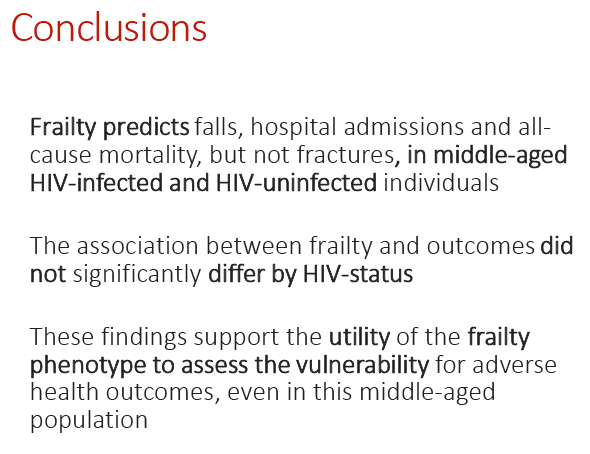
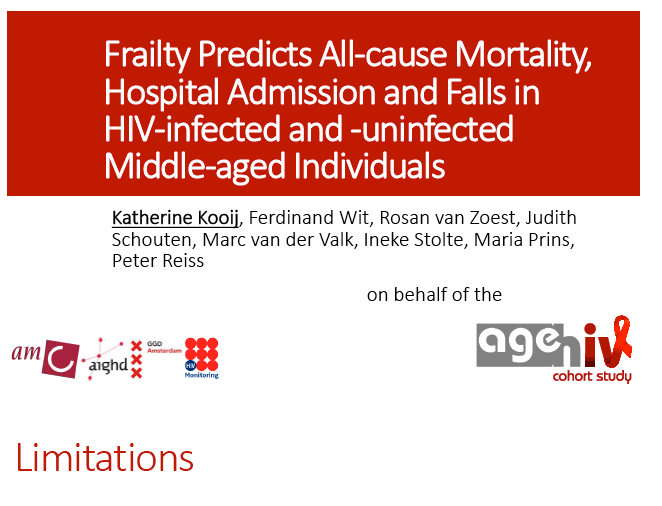
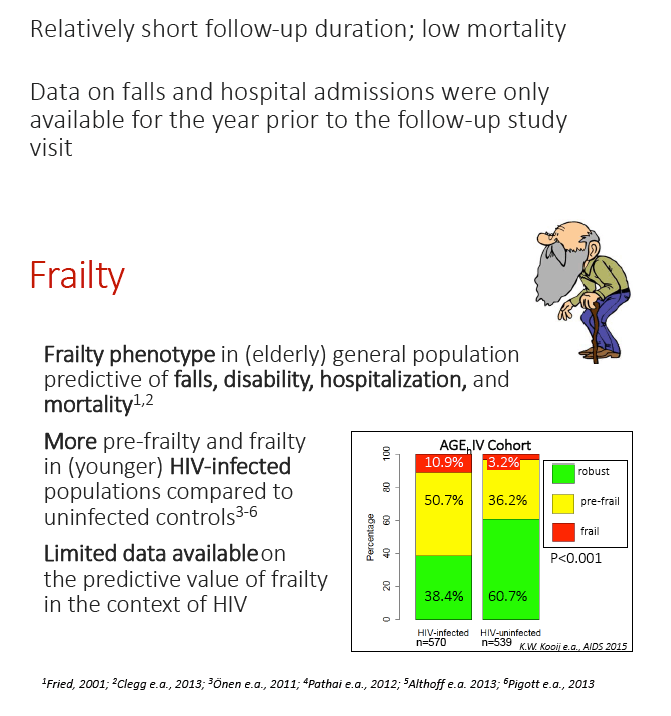

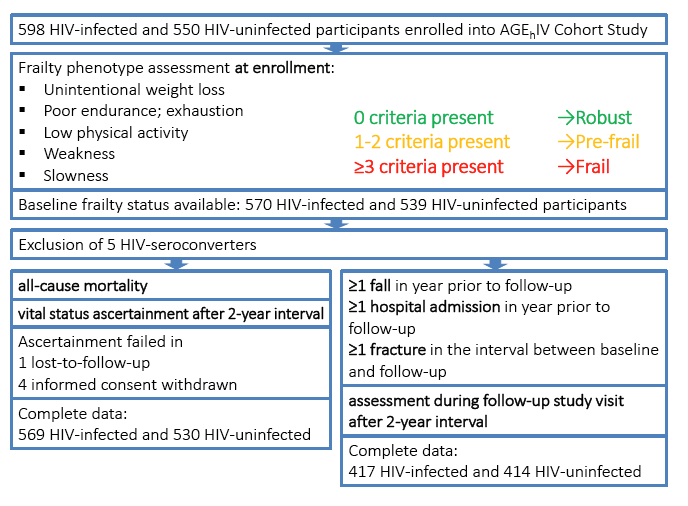
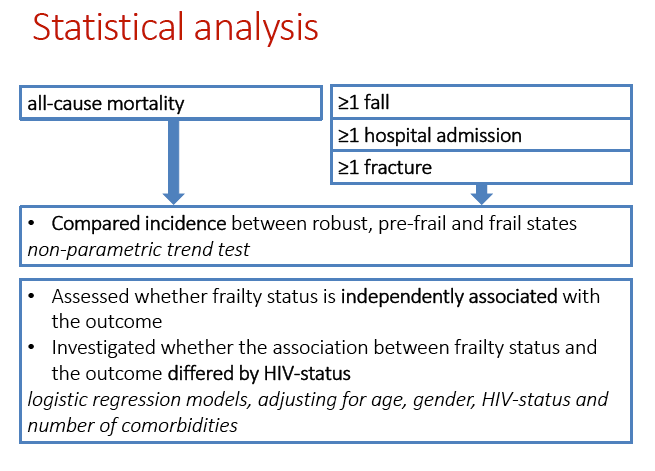
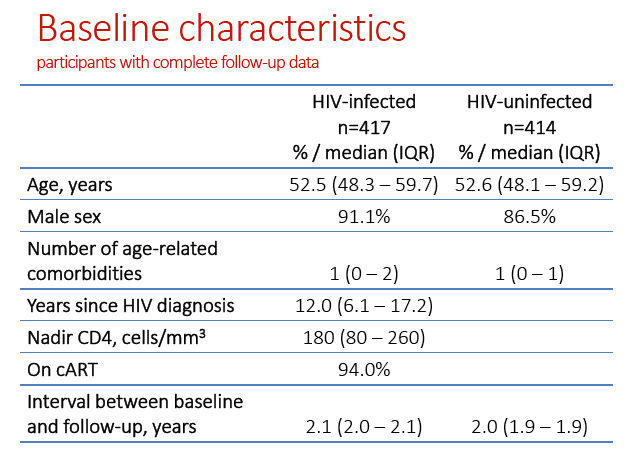
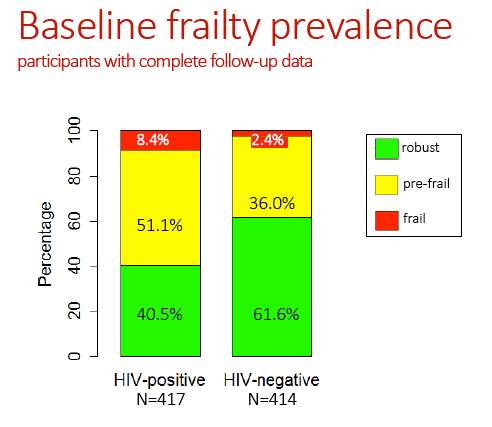

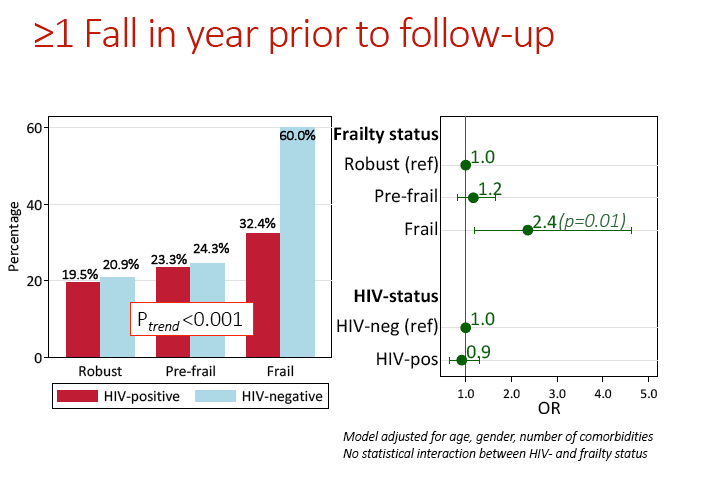
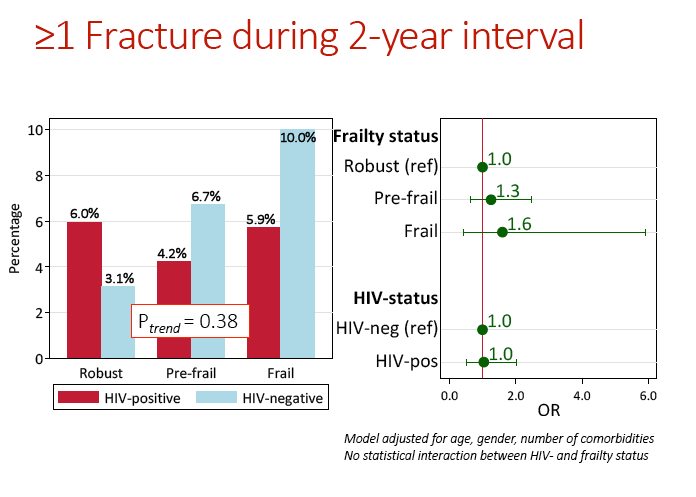
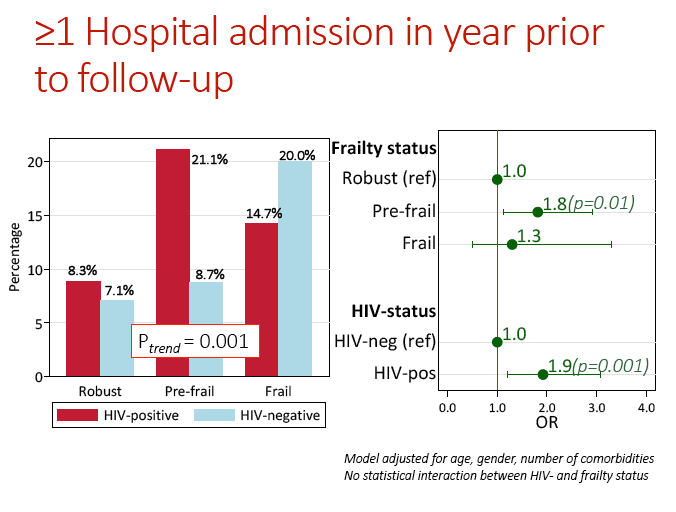
|
| |
|
 |
 |
|
|